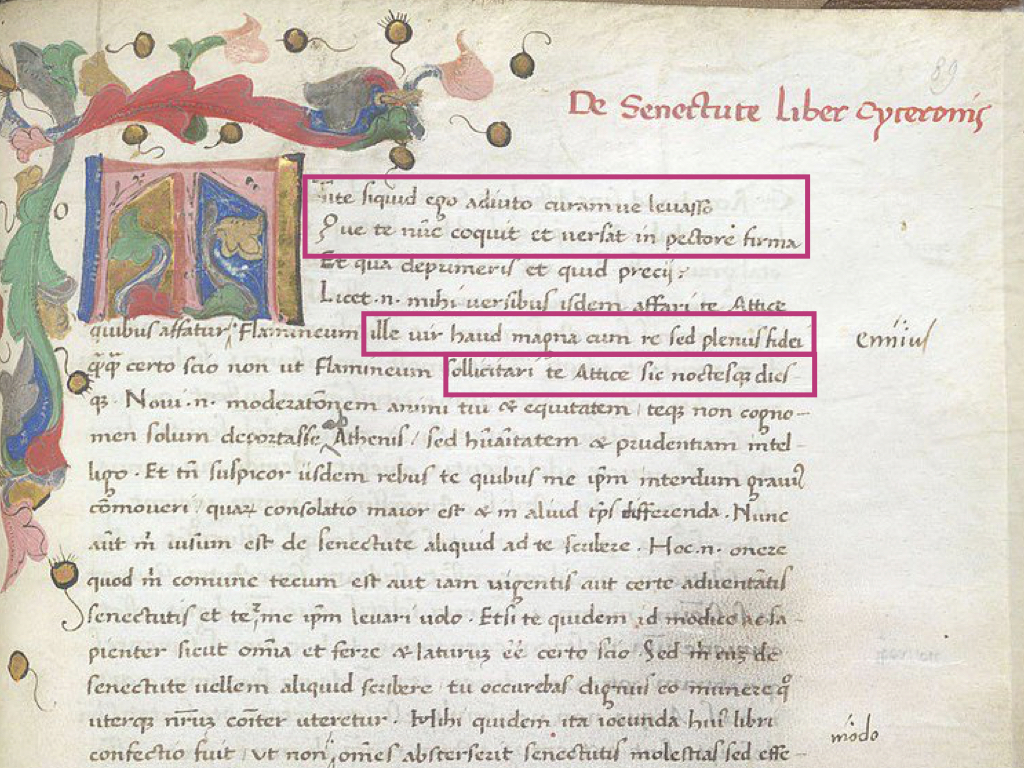Text and audio of an invited lecture given at Swansea Nov 23rd 2020 over zoom. Thank you to Ian Goh for organizing the seminar, and to all of the participants. Click here for the handout.
PART I: LIFE OF THE FRAGMENT
There are two ways that classical fragments are made: they are either (ironically) preserved through an act, or process, of destruction; or they are preserved by enclosure in a later text. The fragments of Sappho are a good and famous example of this process. In the 7th c. BCE, Sappho of Lesbos composed her lyrics; her poetry became so famous that it circulated as a text in nine books, as the ancients report (Suda Σ 107 = Campbell test. 2). But we can’t read Sappho’s poetry in its fullness, the way we read an ancient author whose text was transmitted with a robust manuscript tradition through the middle ages. Instead, what we have are numerous scraps of material, excavated from the sands of Egypt, onto which ancient readers of Sappho had inscribed her words. Sappho is most famous for existing in shards of papyri, but here’s an example of one of her poems which survives today because it was written onto an ostrakon, a broken piece of ceramic:
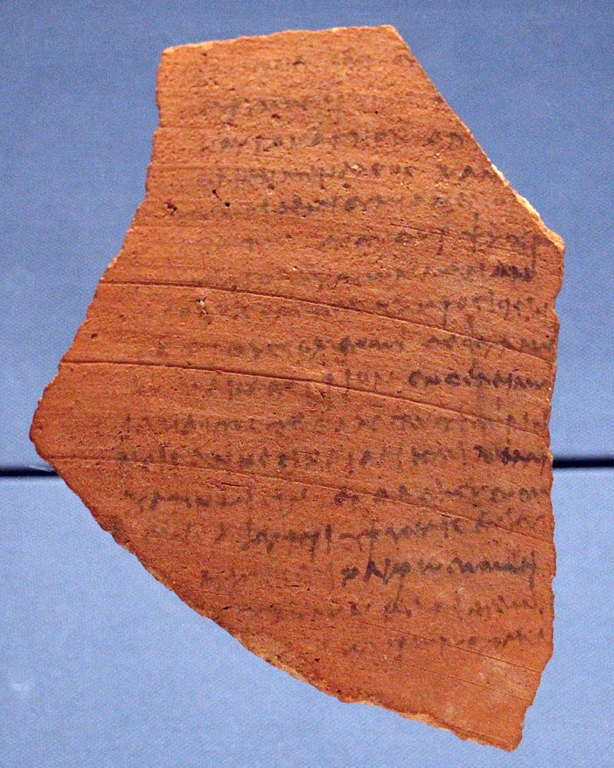
This bit of matter, whose text was first published in 1937 by Medea Norsa, is the reason why we can read what we call Sappho “fragment 2”, a poem which summons the goddess, Aphrodite, from the island of Crete into the presence of the poet. Significantly, this object was made in the 3rd or 2nd c. BCE — that is, several hundred years after the poem inscribed on its surface was originally composed. Here is another Sappho fragment, a scrap of papyrus whose text, published in 1951, contains parts of the famous poem known as “fragment 31.” This piece of papyrus was produced in the 2nd c. CE — even later than our Sappho ostrakon; indeed, this scrap of Sappho papyrus appeared almost a thousand years after the poem inscribed upon it was originally composed:
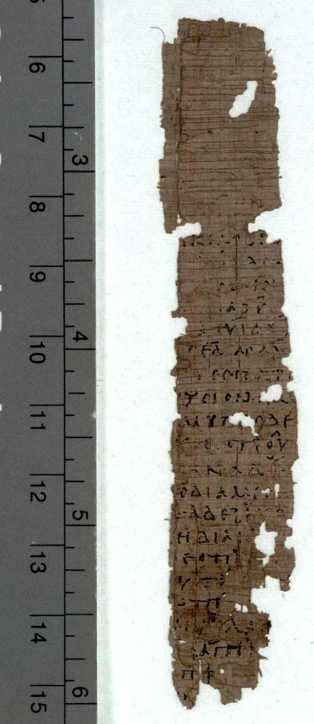
You would be hard-pressed to find a piece of scholarship on fragmentation that does not make reference to the following etymology: the English word “fragment” comes from the Latin frangere, “to break”; therefore, the fragment is, in essence, “the broken thing.” When we contemplate these artefacts of Sappho, brokenness is certainly palpable — particularly in the case of our papyrus sliver, which preserves only a narrow column of Sappho 31. From this perspective, the fragment is not only broken, but broken off from its fuller text — symbolically representing its own partiality. Yet, as I mentioned a moment ago, fragmentation as a process takes place in two ways: the first is preservation through destruction; the second is enclosure, or textual embrace.
In fact, we can use Sappho to demonstrate this second dynamic as well. Returning to our ostrakon: this object gives us the fullest text of Sappho 2, but we actually already had parts of this poem before it was published in 1937, because two ancient authors had quoted her words and embedded them in their own works. Short literary quotations were made by Greek writers in the Roman era: Hermogenes of Tarsus (De Ideis 2.4) in the 2nd c. CE and Athenaeus (Deipnosophistae, 11.463e) in the 3rd c. CE. We can present this information visually:
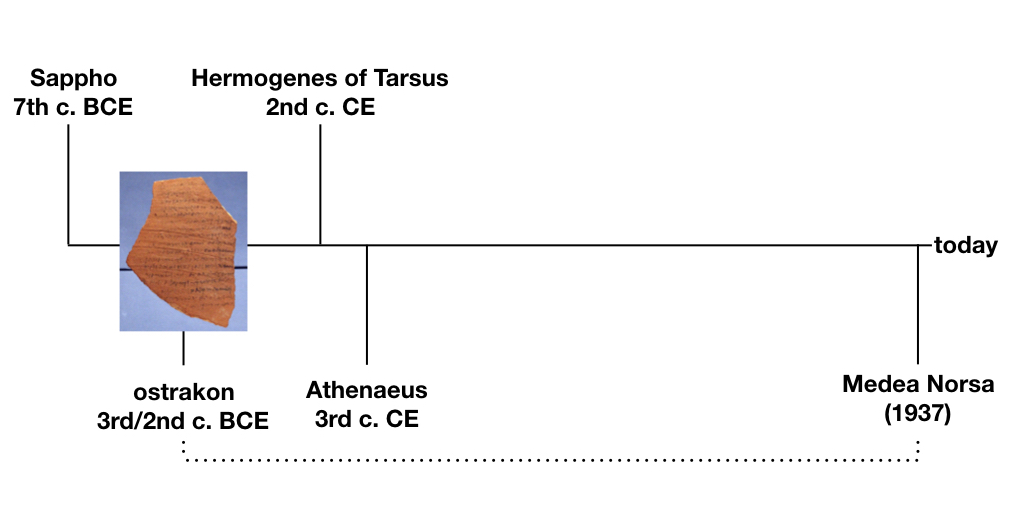
(By the way, this little timeline is obviously not “to scale” chronologically(!), but it will do.) While Sappho’s text was available, broadly speaking, in antiquity, the way in which it has reached us is historically complex — the text that we have now, partial as it is, is the product of several different ancient mediations: someone wrote out the poem on a piece of pottery in Hellenistic Egypt, but we didn’t find that until somewhat recently; in the meantime, Greek writers in the Roman period copied small excerpts of Sappho into their own works, and as a result, carried Sappho with them along their own path of textual survival. Even though the Sappho we imagine belongs to archaic Greece — the Sappho we’ve got was produced by generations of her readers, many centuries after her own era.
Indeed, the fragments of Sappho that are the most famous — such as fragment 31 (φαίνεταί μοι…; “he seems to me equal to the gods”)— survive more fully than most other Sappho poems because they were preserved by textual embrace; that is, because they were quoted by later writers (again: Greek writers in the Roman era): Sappho 31 was quoted by the author of On the Sublime (10.1) in the 1st c. CE. It is a papyrus fragment of Sappho 31 which I showed you a moment ago; we can present this fragment’s history in visual form as well:
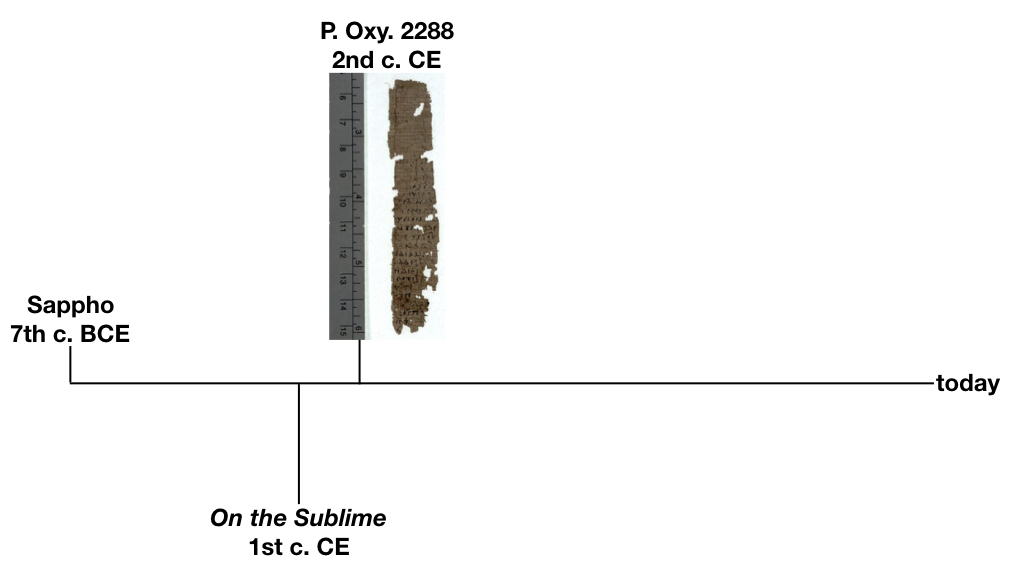
As it turns out, then, examination of Sappho’s textual history demonstrates the extent to which our knowledge of her poetry is mediated by the afterlife (that is: the reception) of her work: it is the fact that later ancient intellectuals became interested in annotating, commenting, and excerpting her work that gives us access to her poetry, even though it is this very history of intellectual practice that is also responsible for certain limitations upon that access.
Crucially, this process which I have just traced in the transmission history of Sappho occurs basically everywhere in the classical tradition. Texts which do not have their own independent manuscript tradition survive for us to read because they have been consciously folded into surviving works by ancient authors. Let me give you a Latin example as well. The works of the 2nd c. BCE Latin poet, Q. Ennius, were deeply influential on the poetry and indeed, the thought, of Roman intellectuals during the Ciceronian period, but Ennius’ works only now survives in fragments. Since material scraps of Latin books don’t survive in the way that ancient Greek books live on in scraps of papyri excavated from Egypt, we rely on the fact that later Latin writers excerpted verses of Ennius, to carry along in their own textual corpus.
Among the most significant excerptors of Ennius is Cicero, who, in the 1st c. BCE, preserved many fragments of Ennius (as well as poetic fragments of several other Latin — and Greek — authors) in his own textual body via the mechanism of citational embrace. Here is a manuscript of Cicero’s De Senectute/“On Old Age” (this 15th c. Italian manuscript is not one of the principals used to establish the text, but it is one which is digitally available; and it’s very nice to look at):
The first words of Cicero’s De Senectute are actually a poetic quotation from Ennius, from his epic, the Annales (Skutsch 337-339; 335; 336); and you can see that a user of this manuscript marked the quotation, writing “Ennius” in the right hand margin. This kind of textual enclosure — voices from earlier times encased in amber by ancient writers — is a fundamental and ubiquitous dynamic of ancient textuality, and in many cases we find ourselves face-to-face with not only one layer of embedding, but a series; enclosure upon enclosure, as intellectuals of each period recursively return to valued texts of the past.
PART II: FRAGMENTARY THINKING/THINKING FRAGMENTARILY
At this point, I basically want to ask: what can we learn about the ancient world, and the way we study the ancient world, by thinking about the fragment — or, by “thinking fragmentarily”? Here are a number of propositions:
1) The fragment by its very nature demonstrates the partiality of our understanding of the ancient world. When we look at a fragment of Sappho, or Ennius, we know that there is something missing, that there is a lack. That lack might have been produced by the randomness of papyrus disintegration; but it is also produced by the selectivity of our excerpting ancient sources: that is, we depend on what Hermogenes of Tarsus wants to show us of Sappho, what Cicero wants to show us of Ennius.
2) As a subset of the first point: the fragment testifies to the partiality of our vision, but it also, inevitably, gestures towards the fact that there were parts of the ancient world — big parts — that were never picked up by texts (and by “text” here, I really mean the ancient artefact in the broadest sense, from text to object to archaeological site) in the first place: the living, breathing parts, the spirit of culture and life which are only accessible or even scrutable to those who experience and contribute to it — the living ancients. The fullness of texts is, in essence, illusory. In reference to this phenomenon, Page DuBois (1995: 53) stated that “all texts are fragments.” That is, texts which survive fully — even if they give the impression of cultural capaciousness, and the possibility of being pressed through to the world which produced them — even these texts present only a partial vision. (This, incidentally, is why our interpretations of antiquity should probably not rely solely on piecing together textual evidence, but ideally will also use a theoretical framework; or at least, not rely on positivism when our sources are demonstrably partial.) When we consider the fact that the ability to produce text in antiquity is dependent upon the writer’s holding of power and social authority, we can appreciate the extent to which so many ancient experiences were not committed to textual form (viz. the relative scarcity of women’s writing; the suppressed narratives of slaves).
Even though fragments often live in the periphery of our discipline (it is only, really, quite recently in the history of the field that they have been studied and theorized as a historical phenomenon in their own right), it is important to remember that fragments, for the most part, represent something that was very famous in antiquity, but which is now difficult to access. Fragments made via enclosure — i.e. because they were quoted by ancient authors — are (generally) preserved precisely due to their authoritative status in antiquity: think of Hermogenes quoting Sappho, Cicero quoting Ennius. For the most part, then, what is contained within an ancient fragment was very famous at the time that the quotation (or enclosure) was made. Fragments interestingly exist as artefacts of inverse quality, depending on what historical point you are able to occupy: to the ancients, the material contained within what would later become a fragment was the most well known; to moderns, the least. Another nice example of this phenomenon is the commentary tradition to the comedies of Aristophanes, which contain a number of fragments of contemporary poets (e.g. the drinking songs of Praxilla of Sicyon; nos. 38 + 41 Balmer = schol. ad Thesm. 528; Wasps 1236); Aristophanes was parodying the most well known cultural touchstones of his day, demonstrating the vitality of the material towards which his plays gesture. If the fragment represents the transmission, via admittedly a complex mechanism, of mainstream information, we are left thinking — what kind of information wasn’t transmitted to us from antiquity?
3) Our understanding of antiquity is mediated, and it is entangled. When we consider the fact of enclosure as a dynamic of fragmentation — that is: when we consider the fact that our knowledge of some parts of antiquity depends on a textual frame — it is easy to be seduced into discarding that frame. In the history of the study of fragments, there have been many editors who wanted to throw away the text which surrounded the fragment: throw away Hermogenes, throw away Cicero, to get to the “pure” nugget within — the nugget of Sappho, the nugget of Ennius. However, in a significant number of cases, the fragment cannot be easily extricated from the framework which preserved it. Anne Carson (1992) has written about the deep entanglement of the fragment of Simonides (fr. 542) in Plato’s Protagoras (339a–346d); and there are many Latin verse fragments in the corpus of Cicero that are so deeply entangled with his prose that it is essentially impossible to separate them. The context of a fragment is, in fact, deeply valuable: not, necessarily, for the reconstitution, or reconstruction of the original, but as a demonstration of the development of ideas — the history of ideas. Again, the fragment forces us to see that our understanding of antiquity is remediated; and it entices us, as well, to value that remediation, rather than ignoring it entirely. As much as we may desire to access these texts in an unmediated fashion, removing fragments from the frames which hold them will not achieve that — and, in the meantime, risks discarding quite useful information about ancient intellectual history.
4) In theory, the fragment should, by its very nature, stand for alterity, heterodoxy, “otherness.” While the contents of fragments represent, to some extent, an ancient mainstream (see: (2)), they challenge modern reconstructions of antiquity which flatten out complex ancient landscapes with narrative oversimplification. Indeed, in important ways, fragmented material presents counternarrative to prevailing thought, especially the back projection of modern identity (straight, white, male) into antiquity: Sappho’s lyric, of course, resists heteronormative sexuality and presents the erotic as a legitimate metaphysic. The modern poet, Josephine Balmer, has explored the heterodox aspect of fragmentation in her recent poetry collection, The Paths of Survival (2017). In this set of poems, Balmer moves backwards in time, starting with the viewing of a papyrus fragment — this one:
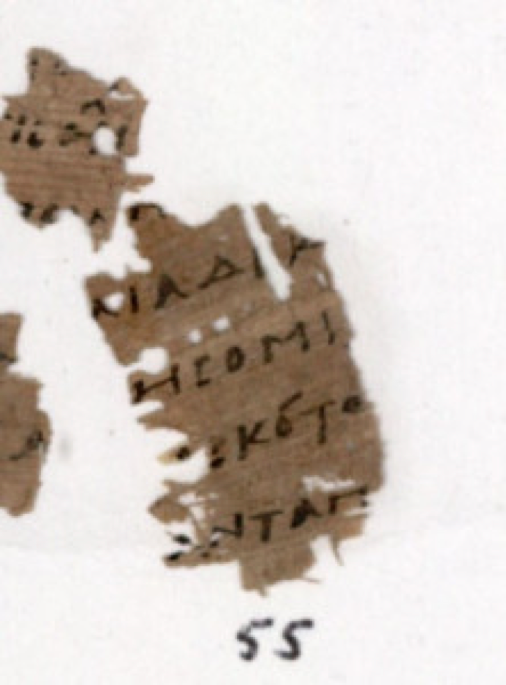
— of Aeschylus’ Myrmidons in the Sackler Library, working through each successive moment of rediscovery and loss, back to Aeschylus himself. Aeschylus’ Myrmidons, in which Achilles and Patroclus were explicitly lovers (see: fragments 135-137; cf. Plato Symp. 180a), famously speaks of gay love with the voice of one of antiquity’s most severe authorities. In The Paths of Survival (2017: 22-23), Balmer dramatizes the rediscovery of a papyrus fragment of the Myrmidons, set against the criminalization of homosexuality under fascism in Italy:
“And then, like the first flicker of smoking fire, slow to take,
I found a tattered word: Antelexa:
My heart turned over. I knew it:
speak out. oppose. dissent.Later there came confirmation
from the professors in Florence;
I had unearthed a precious sliver
of Aeschylus’ lost Myrmidons —a new sigh from a long silence:
A stifled cry shuddering back:
Enough is enough. No more slander,
no more slurs to crush the tongue.
Time now to protest, to dissent.A point of no return. The moment
all the lies might start to shatter”
In the face of fascist neoclassicism, Balmer figures the rediscovery of a scrap of papyrus as a riot; a shattered object which in turn shatters the contemporary construction of reality: in the face of fascist persecution, a fragment of antiquity speaks to the essential legitimacy of homosexuality. This, I think, is the power of the fragment: it presents a challenge. Narratives of the present can be disrupted by fragments of the past.
At the same time, while the ancient fragment disrupts modernity’s conceptions of itself, it does not do so in a manner of simple correspondence. In an Eidolon article from 2018, Sasha Barish reflects upon the extent to which Latin literature reflects the transgender experience. While Barish meditates upon Ovid (rather than a fragmentary text), his words, in my view, reflect “fragmentary thinking”:
“I realized that I loved reading ancient Roman literature around the time I realized I was transgender, and I don’t think the timing was coincidental. I was trans and in high school, and I appreciated Latin poetry not only for its philological beauty but also because it came to me, unabashedly and without explanation, from a different time and from an alien culture. I watched two sets of social rules unfold in parallel. Gender roles existed in the ancient texts, but they were different from what I saw in the world around me. Men fell in love with men, and to some that was nobler than loving girls. Women weren’t supposed to fight in battle, but sometimes they did. Opposite-sex couples had once been individuals existing outside of the gender binary.”
While Barish here demonstrates the power of ancient literature to activate alternatives to dominant narratives, he goes on to make it clear that Ovid’s depiction of gender dynamics is not a one-for-one correspondence to modern experiences. At the same time, Barish recognizes Ovid’s ability to describe a sense of dysphoria which he can relate to, even though Ovid did not intend his words to connote transgender experiences:
“What’s more, I have been able to find a psychological connection between the poem and my own transgender experience—just not in the places I’d expected. The Metamorphoses actually contains some of my favorite pre-modern descriptions of what I’d call dysphoria — psychological, body dysphoria — only it’s never applied to gender.”
That is, even though the fragment can reveal possibilities of human experience that are hidden, sometimes deliberately hidden, from us, it is not simply that the fragment, as a thing that has survived against the odds, testifies to such experiences directly; instead, the fragment may do the work of alterity simply by being a data point that is difficult to deal with, difficult to fit into the narrative of history as it currently stands. We have an option here of saying either: no, this piece of information does not belong with what we already have; or we can say: yes, this piece of information is valuable because it complexifies what we have — places our other texts and objects in higher relief. Part of what I think of as “fragmentary thinking” includes the possibility of expanding our field of vision to include the data point of the fragment alongside what we think we already know, in order to deliberately broaden and complexify the range and depth of our knowledge. The fragment places everything else in higher relief.
5) Fragmentary thinking helps us reconsider the effects of canonization on the wiring of our discipline’s mind. It is, of course, significant that the ancients created a series of canons — that they hierarchized their ideas and their texts; we do not need to erase the fact of those structures. But we can, I think, resist the focus which canonization of texts and ideas produces, to lift our eyes from this tightly defined field of vision. Fragmentary thinking moves us away from the acceptance of canons as natural or neutral by allowing small details to carry as much weight as large structures. Here, I would bring in the work of the 19th c. sociologist, Georg Simmel, whose theory of fragmentation attributed significance to every distinct aspect of human experience, no matter how small. In the Sociology of the Senses (1907: 1026; trans. Frisby 2013: 55), Simmel writes:
“On every day, at every hour, such threads are spun, are allowed to fall, are taken up again, replaced by others, intertwined with others. Here lie the interactions — only accessible through psychological microscopy — between the atoms of society which bear the whole tenacity and elasticity, the whole colourfulness and unity of this so evident and so puzzling life of society.”
While fragments are often conceptualized partitively — that is: as parts of wholes (w-h-o-l-e-s), wholes that are missing — Simmel considered the fragment in abstract as the gateway to the perception of totality. In Sociological Aesthetics (1896; trans. Frisby 2013: 57), Simmel writes:
“To the adequately trained eye, the total beauty, the total meaning of the world as a whole radiates from every single point.”
In such a conceptualization, each individual fragment of antiquity in its own way opens up a portal to totality: from such a perspective, a fragment of Sappho is as important as a Platonic dialogue; a fragment of Ennius as important as Virgil’s Aeneid, principally because it signifies its own position, and because it signifies the relationality of its position. In the meantime, such a distributive theoretical maneuvre allows us to stand back at a distance to observe the contours and the greater shape that each individual piece together presents; to observe the space between things, as well as the space between ourselves and the ancient: in sum, to appreciate a sense of relationality as well as distance.
6) Our understanding of antiquity is not direct; there is a critical distance between us and the ancient world. And that distance is, in fact, data. By virtue of our desire for antiquity, and by virtue of some of our scholarly practices, we often create a false image of antiquity’s unmediated persistence. Take, for example, this image depicting the conservation of a black figure lekythos, recently tweeted by the Boston MFA:

Such an image, unintentionally, presents a narrative that broken things can be fixed; damage can be healed; wholeness can be restored: antiquity is still here. It makes me think of the end of a poem by Adrienne Rich (“Meditations for a Savage Child II”; 1973: 58):
“these scars bear witness
but whether to repair
or to destruction
I no longer know”
Just as I want to insist upon the value of seeing fragments nested within the texts which transmit them, I also want to insist upon the value of presenting the image of broken things as broken — the image on the far left in this triptych. While these may seem to be maneuvres which pull in different directions, each gesture illuminates the journey that ancient materials have taken — whether that means that they have been damaged and have fallen apart, or that they have been swallowed by a subsequent moment in history. These kinds of meditations allow the distance between ourselves and our objects of study to remain present. Despite the fact that the romanticism of loss is a rhetorical component of Classicism, the fact of that loss, or distance, must remain an essential element of our theoretical toolkit, so that self-reflexivity, and awareness of relationality, inform scholarly analysis.
We sometimes act as though we somehow have a direct line to antiquity, that we have our noses pressed right up against the glass. That we can see the ancient world clearly, without interpretative or cultural bias. Other times, we make universalizing claims about ancient material: telling our students (and ourselves) that Greek tragedy, for example, contains the essence of humanity. Classics as a field has, of course, contributed significantly to the definition of “humanity” as a concept (which is distinct from “humanity” as an entity); the BA that I received from Oxford is not called “Classics” but literae humaniores, “more human studies” — implying, apparently, that by virtue of that education my knowledge of humanity is complete. In the US, the situation is much the same: take, for example, the definition of “humanity” made by the famed Commission of the Humanities (sponsored in part by the ACLS) in 1964:
“The humanities may be regarded as a body of knowledge and insight, as modes of expression, as a program for education, as an underlying attitude toward life. The body of knowledge is usually taken to include the study of history, literature, the arts, religion, and philosophy. The fine and the performing arts are modes of expressing thoughts and feelings visually, verbally, and aurally. The method of education is one based on the liberal tradition we inherit from classical antiquity. The attitude toward life centers on concern for the human individual: for his emotional development, for his moral, religious, and aesthetic ideas, and for his goals — including in particular his growth as a rational being and a responsible member of his community.”‘
The definition of humanities as ultimately deriving from Classics (or at least, Classicism), reveals itself to be woefully inadequate in this very description, centred as it is, firstly, on the needs of the individual (rather than the community); secondly, on the male individual. Humanity as an entity has obviously always been more multi-faceted than the way that “humanity” as a concept is here defined. What we reckon with here is a two-fold problem defined: firstly, by the insistence that the Greco-Roman tradition should be the measure of humanism, and as result, a measure of humanity; secondly, the retrojection of our own values back into antiquity, presenting the relationship between the classical world and the modern world (in specifically this case, the US) as a direct line. The dynamism of the fragment, testifying, as it does, to the complexities, the partialities, and the gaps in the transmission of ancient knowledge, is itself again a challenge: this time to the very possibility of revivifying of ancient values, of bringing them back to life. At the same time, we can also appreciate the fact that the selectivity required to define the concept of humanity so narrowly represents a further stage of fragmentation; testifying, crucially, to the fact that fragmentation is an ongoing process in which we are all still taking part.
PART III: PAST, PRESENT, FUTURE
And, of course, it must be directly acknowledged that this definition of humanity, dependent upon classical invocation, has had indisputably violent consequences. For example, as Phiroze Vasunia (2013: 240) has discussed, the British colonial presence in India in the 19th century imagined itself as a “civilizing” force by invoking Classics as the precedent for rule: Robert Needham Cust, a British administrator and judge, wrote in his autobiography (1899: 17) that when he “found [him]self” (as though it were some kind of accident!) “helping to rule Millions in their hundreds of towns and thousands of villages” he could not help but think of Aeneid 6.851-8, which, of course, ends with: parcere subiectis (“spare the conquered”) and debellare superbos (“strike down the haughty”). Edith Hall (2013) described the infamous “Rivers of Blood” (1968) speech by the Conservative MP, Enoch Powell — which quoted Aeneid Book 6 (again; 6.86-7) to incite racial hatred against immigrants — as the moment when “classical literature was put to its most shameful use in the history of British oratory.”
Examples of such invocations of antiquity for modern hatred — where elitism meets racism, sexism, homophobia etc.; that is to say, denials of humanity — are plentiful. The consequences of these historical examples are still with us, and fresh examples are made every day. As modern America roils in the face of violence against Black people, typified, but not limited to, the police murders of George Floyd, Ahmaud Arbery, and Breonna Taylor, we cannot forget the notorious anecdote, discussed by Emily Greenwood (2011: 163), which was attributed to John C. Calhoun, who served as Vice President of the United States (1825-1832); Calhoun reportedly measured the humanity of Black people by their knowledge of Classics, saying:
“if he could find a Negro who knew the Greek syntax, he would then believe that the Negro was a human being and should be treated as a man.”
There are some in the field of Classics who might say: these were utterances made by politicians, not by us; this isn’t us. This is where I want to insist upon the lessons that we learn from the fragment. The fragment says: I am made by reception, I am made by recursive return, I am made by invocation. The fragment says: my life is very long and I mutate as I age; my lifespan represents the intellectual history of ancient ideas; my afterlife is threaded through, entangled with, cannot be separated from, the very history which informs your intellectual and social life. The fragment says: more things are connected than you are currently willing to see.
When Ian Goh asked me to speak as a part of this series — which is called “relevant Classics” — I couldn’t help but think: I have heard anxiety surrounding the extent of Classics’ “relevance” since I myself was a beginning Latin student. The question of “relevance” is deeply interconnected with the perception, and the fact, of Classics’ inherent elitism. For a long time, in both the UK and the US, the study of Latin and Greek was deliberately designed as a programme of elite self-signification; put another way: the elitism in Classics was, quite frankly, the point. Even though the circularity of elitism (study Latin to be elite; elites study Latin) is (maybe) slowly coming apart, the structures erected by the history of this kind of thinking, this curricular design, this hierarchy of access, nonetheless remain. This summer, Dani Bostick published an article in AJP — “Not For All: Nostalgic Distortions as a Weapon of Segregation in Secondary Classics” — which stressed the fact of the Latin classroom as a racialized environment in modern America. Bostick writes (2020: 284):
“While racialized barriers to Classics persist, segregation is euphemistically described as low enrollment; systemic cultural failures are blamed on poor marketing, external trends in education, and regressive pedagogy; and proposed solutions to deeper problems often ignore race, as if all students encountered the same barriers.”
Bostick goes on (correctly, in my view) to pinpoint a nostalgia — or desire — for antiquity as a vital mechanism of the segregated classroom. Bostick (2020: 290) notes the consequence of the nostalgia-driven mentality to classical education as a kind of self-mythologizing which facilitates the acceptance of racially segregated environments: Classics is “for” some people, and not for others. If Classics’ relevance has been defined in relation to its usefulness for such self-mythologizing, then it certainly makes sense that its “relevance” would now feel like it is waning. Amongst all of the claims that we could make about why any student should study the ancient world, we have repeatedly chosen to assert the primacy of our own hierarchical relationships — both to each other, and to the ancient material. In the meantime, even though we market Classics as a way to develop historical consciousness, we habitually turn a blind eye to how we arrived here. The field of Classics is ever mindful of its own relationship to the past (or “a past”, or “some pasts”): the ancient past which we study, and the more recent past which established the frameworks of such study. We keep the past and the present in steady dialogue, but what we also need is a futurist mentality. Futurism requires a sober apprehension of our intellectual history, its consequences. Turning away from material circumstances that we don’t think we’ve caused, while still upholding the systems that created such circumstances, is a mistake.
In this context, “fragmentary thinking”/“thinking fragmentarily” is, I argue, a helpful practice, in that it is inherently self-reflexive and inherently deconstructive. It is a mindset which simultaneously apprehends the complexity of the intellectual tradition while minimizing the kind of romanticism which imagines the ancient to be here with us still in a form that is somehow: perfectly present, perfectly whole, and perfectly understood. The fragment testifies the partiality of our understanding of the ancient world; it points to losses on the micro level as well as on the macro level, allowing us to question to what extent our textual picture of antiquity could ever present a totality such as the one that modern self-mythologizing would need as a foundation. The fragment demonstrates the mediated and entangled nature of our ancient understanding: ancient knowledge is transmitted through a number of filters, which testifies both to the ancient tradition’s tendency to loop back upon itself, as well as to the indirectness of our cultural understanding. The fragment stands for alterity and otherness: not only because fragmentary material often contains challenges to what is found in the mainstream, but in the fact of its potential to represent data which cannot be easily reconciled with what we already know. While the fragment itself is, to a significant extent, representative of canonization, fragmentary thinking can help to loose the hold of canonical thinking, within which texts gain greatest weight by virtue of the doctrine of “survival of the fittest.” Finally, and crucially, I think: the fragment, in all these ways, illuminates distance; it communicates the journey which ancient knowledge has taken to reach us, and, as a result, it plants us historically in our own position, here in modernity. THANK YOU.
Thanks to @opietasanimi and @SUAncientWorld for this interesting presentation on the importance of Fragments for our knowledge of the Ancient World 📜 pic.twitter.com/anQ2SJHZKW— MarikaStrano (@marika_strano) November 23, 2020
https://platform.twitter.com/widgets.jsThrilled to have gotten to hear @opietasanimi presenting “The Fragment and the Future” at the Swansea Seminars.
— Christian Lehmann (@BuffyAntiqua) November 23, 2020
What a moment near the end, the anaphoric crescendo of “the fragment says…”🔥 pic.twitter.com/gOUlEnifpG
#SwanseaAncientSeminars
TODAY: 23/11, 5pm GMT:
Dr Hannah Čulík-Baird @opietasanimi:
‘The Fragment & the Future’
Thinking about fragments & how we get them: what’s the impact on our discipline?#fragments #Classics
How to attend: https://t.co/NaO1bfCCtM@SwanUniCOAH @SwanseaUni pic.twitter.com/9iXScd454k— Swansea Uni Ancient World (@SUAncientWorld) November 23, 2020
